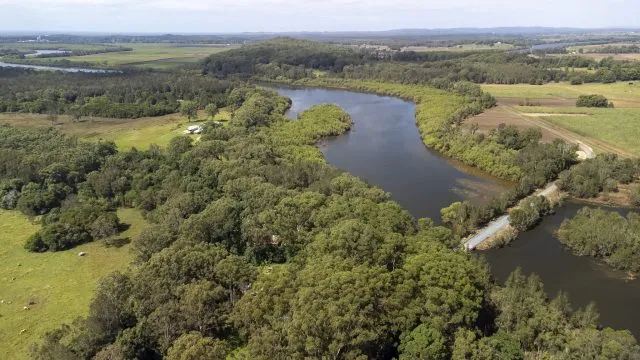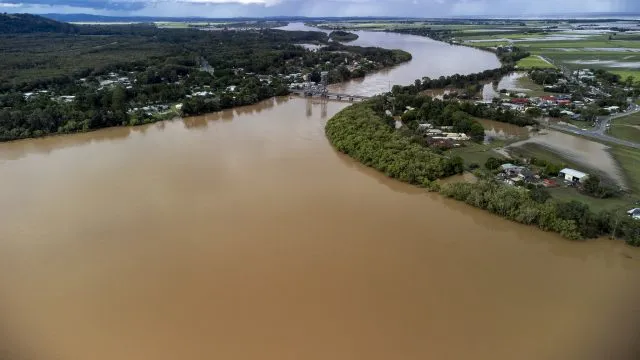
SCU scientists are investigating the deoxygenation of the Richmond River following recent flooding, which has caused massive fish kills.
After the worst flooding event on record, followed a month later by renewed flooding, the full extent of the environmental impact is still being assessed, including severe deoxygenation of the Richmond River system.
Scientists at Southern Cross University were already undertaking long-term monitoring of the Richmond River water quality with research partners Rous County Council and the NSW Department of Planning and Environment.
In the wake of this natural disaster, the team has deployed additional loggers to measure oxygen throughout the river system and are working on repairing the existing logger network which was decimated by the floods.
No oxygen
Project leader Professor Damien Maher from the University’s Faculty of Science and Engineering said the deoxygenation of the water was extensive.

‘After the first flood in late February there was no oxygen in the river between Ballina and Coraki. That’s around 60 kilometres of river and estuary with no oxygen and therefore no fish.
‘A lot of the dead fish were washed out to sea during this event due to the magnitude and duration of the flood,’ Professor Maher said.
According to Professor Scott Johnston, a Landscape Hydrogeochemist also from the University’s Faculty of Science and Engineering, deoxygenation often occurs in the lower parts of the Richmond River after large floods, particularly during the warmer months.
‘Deoxygenation happens when floodwaters overtop the riverbanks and spill out onto the lower floodplain covering vegetation and organic matter such as grasses. When this vegetation starts to decay and rot in the floodwaters it can deplete all the oxygen in the overlying water,’ he said.
While zero oxygen in the water can cause large fish kills, Professor Johnston says it’s just the visible tip of the ecological iceberg.
‘While the essence of this process is a natural part of the aquatic carbon cycle, human modification of the lower floodplain has unintentionally made these events more frequent and more severe than they would otherwise be,’ he said.

Second wave
As the flood waters slowly recede, researchers say a ‘second wave’ of impact will follow as the floodplains begin to drain.
Professor Maher’s research team is conducting experiments on the water draining off the floodplain to assess how it will exacerbate the current low oxygen event and contribute to other contaminants such as metals and acids.
‘Large areas of the floodplain have acid sulphate soils in them at fairly shallow depth. So, once the flood recedes and the surface water drains away, it starts pulling the shallow ground water from the wetlands into the river which has high levels of sulphuric acid and metals,’ said Professor Johnston.
‘This is an ongoing issue that the Richmond has been facing. Often after these flooding events the river is not only subject to deoxygenation and fish kills, but also acidification and low pH levels, particularly in the tributaries like Broadwater and Rocky Mouth Creek.’
The metal contaminants draining off the floodplains can also be highly toxic to aquatic life, causing secondary fish kills.

New opportunities
Looking toward recovery, Professor Maher believes that scale of the flooding event has made room for a new opportunity.
‘The sheer scale of this flood has meant that all those fine sediments that wash off from other smaller flood events and deposit on the river bed have been scoured out. So, we’ve nearly had a reset of the system where it’s been taken back to something closer to the original morphology prior to developing the catchment,’ he said.
‘If there are ways to stop the excess sediment in the upper catchment that’s been moved around through these landslides and prevent that from getting back into the river, we may actually be looking at a river system that’s partly reverted back towards its natural state. So, there’s opportunity to enhance that trajectory in a positive way.’
The research team will continue water quality monitoring and research to track the recovery of the Richmond River system, integrating the data into a model which will help to provide a predictive tool for assessing fish kills into the future.
Collaboration
Professor Mary Spongberg, Deputy Vice Chancellor (Research) at Southern Cross University, said ‘As a Northern Rivers university directly impacted by this severe flooding event, we’re working closely with the community and our long-term research partners to drive innovative research in water quality and mitigate the environmental impacts of future flooding events.’

The Estuaries and Catchments Science (ECS) unit of the NSW Department of Planning and Environment (DPE) has been working closely with the University to provide real time data and interpretation of post-flood water quality dynamics and fish kills in the Richmond River.
‘This effort has included boat-based surveys and the strategic installation of water quality loggers. We have provided regular updates to a forum of key stakeholders including DPI-Fisheries, Rous County Council, and local council officers,’ said DPE Senior Research Scientist Angus Ferguson.
‘The ECS unit has also coordinated funding from the Marine Estate Management Strategy to create an Industry Fellow position at Southern Cross University to support ongoing monitoring of ecosystem health in the Richmond River into the future,’ he said.
‘This program will help to further develop automated water quality monitoring technology for the Richmond River.’




So when you have petrol stations in flood basins, septic in flood basins.It doesn’t supprise me at all that when it flood’s it kills all The fish 🐟🎏🐟